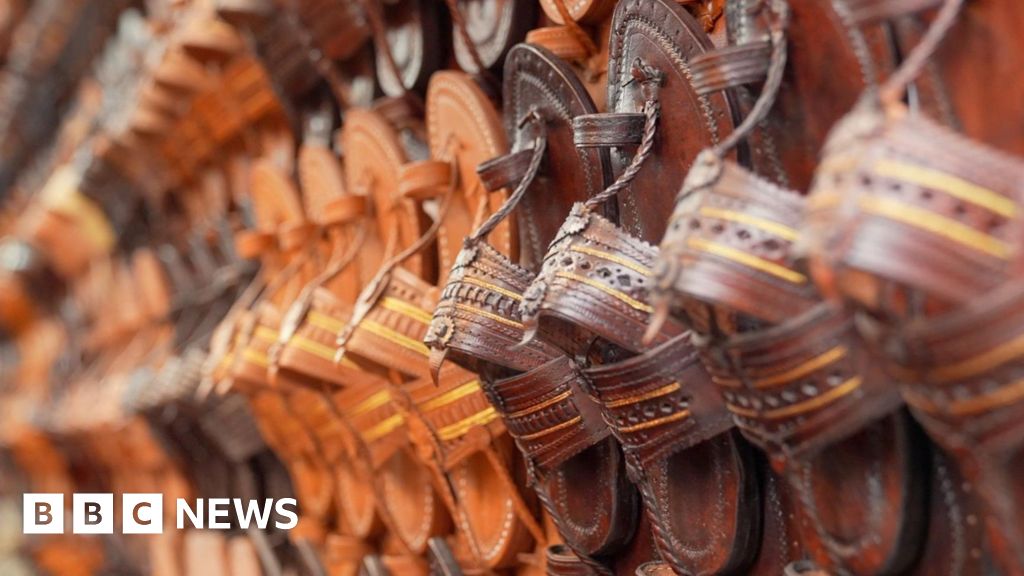BBC News
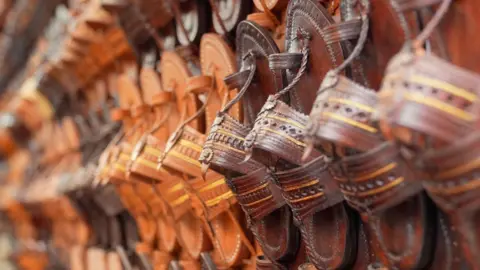 BBC
BBCThe Western Indian town of Kolhapur has found itself in an unlikely global spotlight, as thousands of local artisans who hand-craft traditional leather footwear are mounting a collective attack on luxury fashion label Prada for plagiarising their designs without credit.
The rhythmic pounding of the hammer in 58-year-old Sadashiv Sanake’s dimly lit workshop bears witness to the hard grind behind handcrafting the iconic Kolhapuri leather sandals.
“I learnt the craft as a child,” he tells the BBC. A day’s toil goes into making just “eight to 10 pairs” of these sandals he says, that retail at a modest $8-10
Barely 5,000 artisans in Kolhapur are still in the profession – a cottage industry that struggles to compete in a mechanised world, caught in the funk of dismal working conditions and low wages.
It’s no surprise then that when Italian luxury brand Prada released a new line of footwear that bore a striking resemblance to the Kolhapuri sandals – but didn’t mention the design origins – local artisans were up in arms.
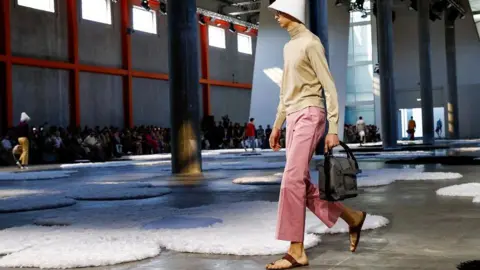 Reuters
ReutersThe backlash was swift. Social media was flooded with accusations of cultural appropriation, prompting Prada to issue a statement acknowledging the sandals’ roots.
Now local politicians and industry associations have thrown their weight behind the artisans who want better recognition of the craft and its cultural legacy.
Mr Sanake was not aware of Prada’s show until the BBC showed him a video of it. When told that that the sandals could retail for hundreds of pounds in luxury markets, he scoffed. “Do they have gold in them?” he asked.
Prada hasn’t revealed the price tag but its other sandals retail at between £600 to £1,000 in the UK as per its website.
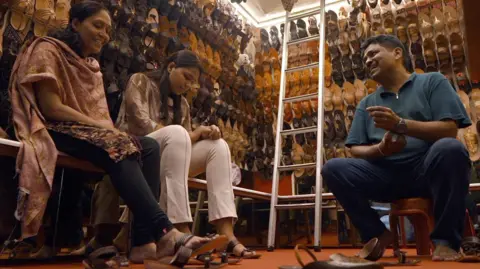
The earliest records of Kolhapur sandals date back to the 12th Century.
“These sandals were originally crafted by members of the marginalised Charmakar (cobbler) community, also known as chamars,” said Kavita Gagrani, a history professor at the New College in Kolhapur.
Chamar is a pejorative caste term used to describe Dalits (formerly known as untouchables) who work with animal hides.
“But in the early 20th Century, the craft flourished when the then ruler of Kolhapur, Chhatrapati Shahu Maharaj granted royal patronage to this community,” Ms Gagrani said.
Today, nearly 100,000 artisans across India are engaged in the trade with an industry worth over $200m, according to the Maharashtra Chamber of Commerce, Industry & Agriculture (MACCIA), a prominent industry trade group.
Yet, most of them continue to work in unorganised setups under dismal conditions.
“I was never educated. This is all I know, and I earn about $4-5 a day, depending on the number of orders,” said 60-year-old Sunita Satpute.
Women like her play a critical role, particularly in engraving fine patterns by hand, but are not compensated fairly for their long hours of labour, she said.
That’s why Sunita’s children don’t want to continue the craft.
A short distance away from her workshop lies Kolhapur’s famous chappal gully, or sandal lane, a cluster of storefronts – many of them struggling to stay afloat.
“Leather has become very expensive and has pushed up our costs,” said Anil Doipode, one of the first sellers to open a shop here.
Traditionally, artisans would use cow and buffalo hide to make these sandals. But since 2014, when the Hindu nationalist Bharatiya Janata Party (BJP) came to power, there have been several reports of vigilantes – self-appointed protesters or activists – cracking down on alleged cow slaughter, sometimes with physical violence. The cow is considered sacred by Hindus.
In 2015, Maharashtra state banned the slaughter of cows and the sale and consumption of beef, forcing artisans to rely on buffalo leather sourced from neighbouring states, pushing up their production costs.
Traditional sellers are also struggling to compete with synthetic copies flooding the market.
“Customers want cheaper sandals and can’t always tell the difference,” said Rohit Balkrishna Gavali, a second-generation Kolhapuri sandal seller.
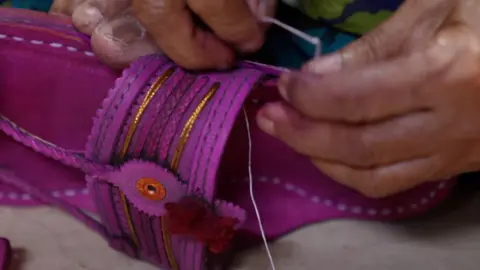
Industry experts say the controversy highlights the need for a better institutional framework to protect the rights of artisans.
In 2019, the Indian government had awarded Kolhapuri sandals the Geographical Indication (GI) – a mark of authenticity which protects its name and design within India, preventing unauthorised use by outsiders.
Globally, however, there is no binding law that stops other countries or brands from aesthetic imitation.
Aishwarya Sandeep, a Mumbai-based advocate, says that India could raise the issue at the World Trade Organization under its TRIPS (Trade-Related Aspects of Intellectual Property Rights) agreement, of which it is a signatory.
But the system is cumbersome, expensive and often lacks enforceability, both in India and abroad, she adds.
Lalit Gandhi, the president of MCCIA, says his organisation is planning to patent the Kolhapuri sandal design, hoping to create a legal precedent for future cases.
But some say real change can only happen when India starts seeing its traditional heritage in a different light.
“It’s about ethical recognition. India must push for royalty-sharing and co-branding,” says Ritu Beri, a renowned designer. “The more we take pride in our culture, the less we will be exploited.”
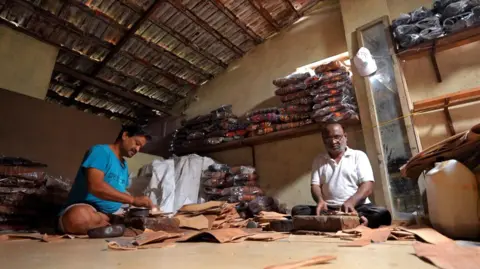
Of course, this isn’t the first time a global fashion brand has been accused of appropriating Indian handicrafts.
Many big labels have featured Indian fabrics and embroidery work with little to no artist collaboration. “Take Chikankari (a delicate hand-embroidery style from the northern Indian city of Lucknow), Ikat (a cloth-dyeing technique), mirror work; they’ve all been used repeatedly. The artisans remain invisible while brands profit from their inspiration,” Ms Beri says.
Mr Gandhi, however, says that Prada’s endorsement of Kolhapuri sandals could also be beneficial for artisans.
“Under their label, the value [of Kolhapuri sandals] is going to increase manifold,” he says. “But we want some share of that profit to be passed on to artisans for their betterment.”
Rohit Balkrishna Gavali, a sandal-seller in Kolhapur, agrees – he has already begun to see the difference.
“The design Prada used wasn’t even very popular, but now people are asking for it, with clients from Dubai, the US and Qatar” placing orders, he says.
“Sometimes, controversy can help,” he adds. “But it would be nice if it also brought respect and better prices for those keeping this tradition alive.”
The issue is unlikely to die down soon.
For now, a plea has been filed in a high court, demanding Prada pay damages and compensation to artisans, along with a court-supervised collaboration between the luxury label and artisan associations.
Prada has told BBC in a statement that it is in talks with the MCCIA on this matter.
Mr Gandhi, its chief, says a meeting between the two sides is going to take place next week.
Follow BBC News India on Instagram, YouTube, Twitter and Facebook.


